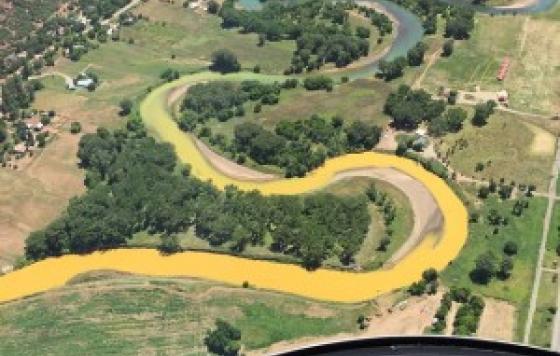By Jennifer Peters, National Water Campaigns Coordinator (Follow Jennifer on Twitter - @EarthAvenger)
Update - February 18, 2014: Click here to tell EPA to Put Drinking Water First and Protect Communities from Coal Ash!
The motto for the City of Danville, Virginia is “The river city, where innovation flows.” Since Sunday night, the River City has been where coal ash flows. As I posted Wednesday, Duke Energy has been scrambling to stop the flow of coal ash wastewater from one of its ash ponds since a stormwater pipe beneath the pond ruptured Sunday afternoon. The ash pond, located near Eden, North Carolina, is approximately 20 miles upriver from the city of Danville, VA, which gets its drinking water from the Dan River. Our friends Catawba Riverkeeper have created this timeline of events for the ongoing spill. It’s been over five days – and I am beginning to wonder, how many Duke Energy engineers does it take to fix one broken pipe? Sounds like the beginning of a bad joke.
The more I learn about this situation, the more appalled I am at Duke Energy’s incompetence. They took over four hours to report the spill to the North Carolina Department of the Environment and Natural Resources and it was more than 24 hours later before the spill was made public. Duke initially claimed that the broken pipe was made of reinforced concrete, but on Wednesday they revealed that the 50-year –old pipe is actually made of a much weaker material – corrugated metal. How did they not even know what material their storm water pipe was made of and, even more perplexing, why on earth did it take them three days to figure that out?
Though the spill has been ongoing since Sunday (by now it has slowed to a trickle, since most of the toxic wastewater has already drained into the Dan River), Duke Energy has yet to update its initial spill estimate of 82,000 tons of coal ash and 25 to 27 million gallons of wastewater. So no one really knows how much toxic ash and wastewater poured into the river.
Yesterday the North Carolina Department of Natural Resources released its initial water quality test results, and while the state did not give the Dan River “a clean bill of health,” N.C. Division of Water Resources Director Tom Reeder said “the findings that water quality in the river met state standards were very encouraging.” Should all the fish in the Dan River be flipping for joy? Not really. The state collected water samples more than two miles downriver from the spill site. In contrast, Waterkeeper Alliance collected samples a few feet downstream from the spill and, not surprising, their results were dramatically different. Waterkeeper found that the river was contaminated with arsenic, lead, iron, chromium and other toxic metals commonly found in coal ash at levels that grossly exceed state and federal water quality standards.
But wait – there’s more. North Carolina Governor Pat McCroy used to work for Duke Energy. Maybe that’s why it took him four days to ask Duke Energy to stop the spill.
This spill didn’t have to happen – it was the result of decades of lax state and federal regulations. For years Duke Energy claimed their coal ash ponds posed no threat to North Carolina’s water, despite concerns from citizens, environmental groups, and the state. As dramatic as this spill is, this type of pollution is far too common. There have never been federal regulations for coal ash disposal and most states allow power plant utilities to store ash in unlined ponds, dozens of which are known to have contaminated rivers, lakes and streams across the country. Even more, every day across the country, power plants dump millions of gallons of wastewater from their coal ash ponds directly into rivers, lakes, streams and bays. Because of this reckless practice, 5.5 billion pounds of toxic metals, nutrients and other harmful chemicals end up in our nation’s water every year. You can read more about that here.
Related Posts
Stay Informed
Get the latest updates and actions:
Thanks for signing up!
There was a problem processing your signup. Please try again.


